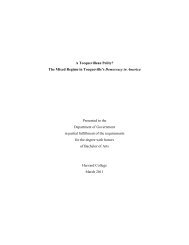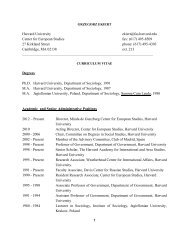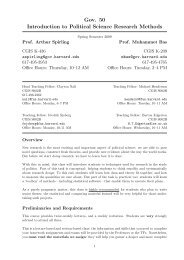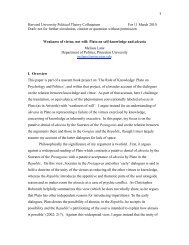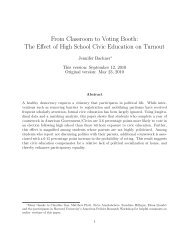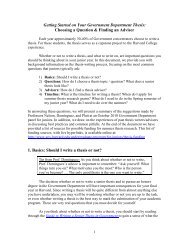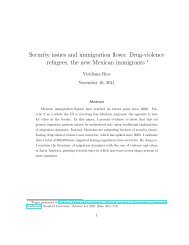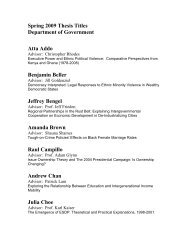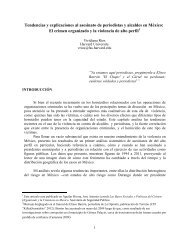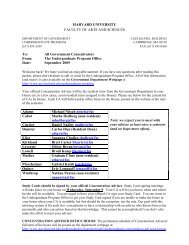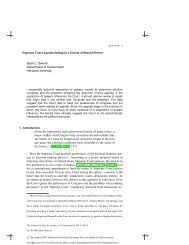Why did Mexico become so violent? - Department of Government ...
Why did Mexico become so violent? - Department of Government ...
Why did Mexico become so violent? - Department of Government ...
Create successful ePaper yourself
Turn your PDF publications into a flip-book with our unique Google optimized e-Paper software.
Author's per<strong>so</strong>nal copy<br />
Trends Organ Crim (2013) 16:138–155 153<br />
federal troops to control violence in December 2006. Enforcement operations led to a<br />
self-reinforcing <strong>violent</strong> equilibrium by indirectly triggering more competition between<br />
traffickers because it lead to the capture or assassination <strong>of</strong> high-ranking<br />
traffickers, and to splits and conflicts within the remaining traffickers. A very clear<br />
case <strong>of</strong> the self-reinforcing <strong>violent</strong> equilibrium in action was demonstrated for the<br />
state <strong>of</strong> Guerrero. When lieutenants <strong>of</strong> the Sinaloa Cartel were captured as a result <strong>of</strong><br />
law enforcement operations, the remaining members <strong>of</strong> the criminal organization<br />
could not keep working together. The replacement <strong>of</strong> leaders within the Sinaloa<br />
Cartel resulted in an internal confrontation, spiraling violence out <strong>of</strong> control.<br />
Conclusion<br />
With almost 41,648 drug-related homicides in the country in the last 4 and 1/2 years,<br />
<strong>Mexico</strong> has changed nearly beyond recognition. Some cities, particularly those<br />
located close to the U.S. border, have experienced spikes in violence that transformed<br />
them into war zones, in a very literal sense. <strong>Mexico</strong>’s recent changes are particularly<br />
puzzling given that the country has long been a large supplier <strong>of</strong> drugs into the US<br />
and had always filled this role in a non-<strong>violent</strong> manner. The purpose <strong>of</strong> this article has<br />
been to explain the rea<strong>so</strong>ns behind these changes in drug-related homicides. Using<br />
the case <strong>of</strong> La Familia, a drug-trafficking organization operating mainly in the states<br />
<strong>of</strong> Michoacán, Guanajuato, and Guerrero, this study shows that <strong>Mexico</strong>’s trafficking<br />
industry went from a stable, peaceful equilibrium into a self-reinforcing <strong>violent</strong><br />
equilibrium because <strong>of</strong> increases in illegal-drug market competitions and in law<br />
enforcement operations.<br />
Drug-related violence can be explained as the outcome <strong>of</strong> two variables: (1)<br />
homicides caused by traffickers confronting each other to compete for territories<br />
(“competition”), and (2) enforcement operations conducted by authorities to capture<br />
drug traffickers (“enforcement”). Violence resulted when illegal markets became<br />
more competitive as a result <strong>of</strong> changes in <strong>Mexico</strong>’s drug-trafficking industry. Lacking<br />
a central enforcement agency to deal with these changes, violence erupted.<br />
Violence al<strong>so</strong> increased when enforcement operations against traffickers were conducted<br />
by the authorities. As the quantitative model showed, for each instance <strong>of</strong><br />
competition or enforcement measured, the number <strong>of</strong> drug-related targeted executions<br />
increased by 0.979.<br />
Enforcement operations have had a further damaging effect which has locked<br />
<strong>Mexico</strong> into a self-reinforcing <strong>violent</strong> equilibrium. When traffickers are killed or<br />
captured by the government, the internal structure <strong>of</strong> criminal organizations destabilize,<br />
which provides further incentives for other organizations to try to take control<br />
over the territory <strong>of</strong> the weakened one. Furthermore, the process <strong>of</strong> replacing<br />
leadership within a trafficking organization is inherently complex, which means that<br />
in most cases, the capture <strong>of</strong> the leader leads to internal battles within the drug<br />
trafficking organizations.<br />
This study shows that the rea<strong>so</strong>ns why <strong>Mexico</strong> has <strong>become</strong> <strong>violent</strong> can be<br />
understood by looking at La Familia areas <strong>of</strong> operation. The interaction <strong>of</strong> competition<br />
and enforcement is what has brought the country into the vicious cycle <strong>of</strong><br />
violence that we call the drug war. Mexican authorities have followed a strategy <strong>of</strong>



